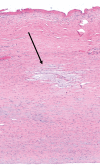Giant ascending aortic aneurysm with impending rupture as presentation of cutis laxa 1B: a case report
- PMID: 38025136
- PMCID: PMC10660401
- DOI: 10.1093/ehjcr/ytad530
Giant ascending aortic aneurysm with impending rupture as presentation of cutis laxa 1B: a case report
Abstract
Background: Thoracic aortic aneurysms are rarely symptomatic but can result in acute aortic syndromes, associated with a high mortality rate. While most cases may be acquired, a genetic basis is evident in approximately 20-25% of the cases, especially among patients under 50 years of age, and those exhibiting syndromic features or family history. Although autosomal dominant inheritance is predominant in familial aortopathies, exceptions exist, such as cutis laxa 1B (CL1B)-related aortic disease, caused by variants in EFEMP2 gene, that follows an autosomal recessive inheritance pattern.
Case summary: We present the case of a 26-year-old male with a giant ascending aorta aneurysm and massive pericardial effusion, which was ultimately diagnosed of CL1B due to the p.Ser137Cys variant in the EFEMP2 gene in homozygosis. The patient underwent successful ascending aorta replacement (Bentall´s procedure). There were not complications or further events after 2 years of follow-up.
Discussion: This case underscores the importance of genetic testing in young patients presenting with aortopathies, syndromic features, or atypical presentations, irrespective of family history.
Keywords: Aortic aneurysm; Case report; Cutis laxa; EFEMP2; Genetics.
© The Author(s) 2023. Published by Oxford University Press on behalf of the European Society of Cardiology.
Conflict of interest statement
Conflict of interest: None declared.
Figures






References
-
- Thakker PD, Braverman AC. Cardiogenetics: genetic testing in the diagnosis and management of patients with aortic disease. Heart 2021;107:619–626. - PubMed
-
- Loeys B, De Paepe A, Urban Z. Genereviews®. Seattle: University of Washington; 2023. p3–517.
-
- Al-Hassnan ZN, Almesned AR, Tulbah S, Hakami A, Al-Omrani A, Al Sehly A, et al. . Recessively inherited severe aortic aneurysm caused by mutated EFEMP2 Am J Cardiol 2012;109:1677–1680. - PubMed
Publication types
LinkOut - more resources
Full Text Sources
